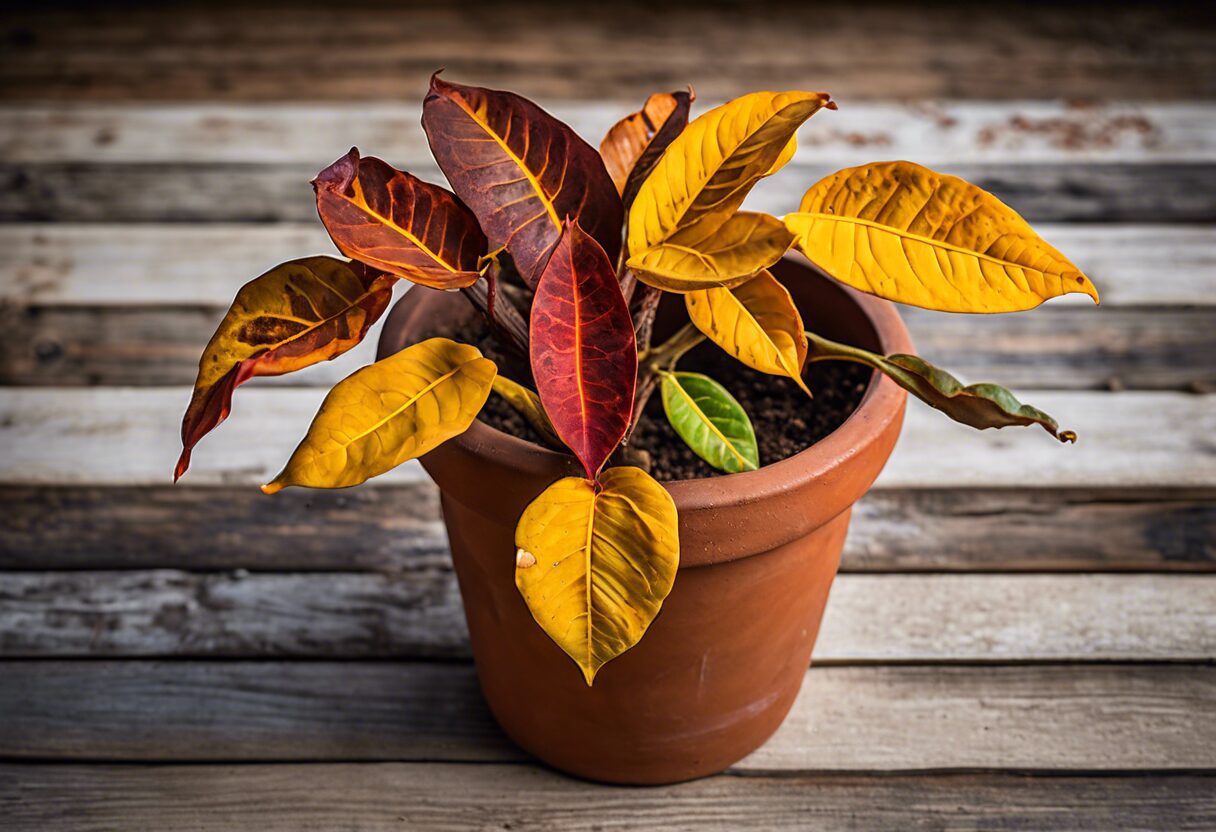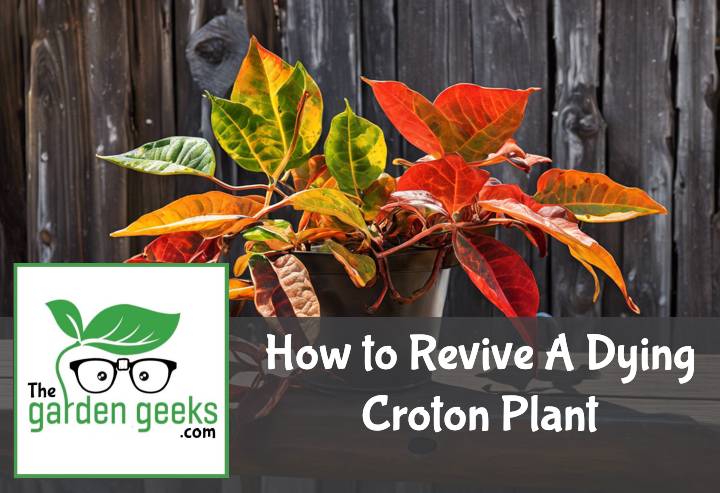Hey there, green thumb! Ever found yourself staring at your beloved croton plant, wondering why it’s looking a bit…well, under the weather? You’re not alone. We’ve all been there. Heck, I once had a croton that looked like it had partied harder than a rockstar on tour. But don’t fret! Here’s the good news: learning How to Revive A Dying Croton Plant is easier than you think.
In this guide, we’ll embark on an epic journey – from understanding what makes our leafy friends tick to practical tips and tricks for bringing them back from the brink. So buckle up and keep reading about how to revive a dying croton plant. It’s going to be a wild ride!
Key Takeaways
- Identify the problem with your Croton plant: overwatering, underwatering, or pest infestation.
- For overwatered plants, let the soil dry out before watering again. Underwatered plants need regular watering until the top inch of soil is moist.
- Use a neem oil solution to treat pest infestations.
- Provide adequate light and humidity for the plant’s recovery.
- Repotting may be necessary if root rot has occurred. Use fresh potting soil and ensure proper drainage.

Understanding the Croton Plant
Now, let’s get to know our green friend a bit better. The Croton plant, a vibrant and colorful houseplant, is native to the tropical forests of Southeast Asia and Oceania. It’s known for its stunning foliage, which can turn any dull corner into a lively spot.
What is a Croton Plant?
A Croton plant is like that one friend who always dresses in bright colors – you can’t miss it! Its leaves are its glory, flaunting shades of red, yellow, and even purple. And guess what? No two leaves are the same! Talk about being unique.
The growth patterns of Croton plants are also interesting. They love reaching out for the sun, growing upwards and outwards. But remember folks, they’re not fans of change – moving them around too much can cause leaf drop.
Recognizing a Healthy vs. Dying Croton Plant
It’s time for some real talk on how to revive a dying Croton plant. First things first – we need to understand what a healthy one looks like versus one that’s knocking on heaven’s door.
A healthy croton has vibrant leaves with no signs of wilting or discoloration. It stands tall and proud like it owns the place (which it kinda does). On the other hand, if your croton starts dropping leaves or showing brown spots, it might be sending an SOS signal.
The key here is observation – keep an eye on your plant buddy. If you notice any drastic changes in its appearance or behavior (yes, plants have behaviors too), it might be time to step in and save the day!
Identifying Causes of a Dying Croton Plant


Alright, let’s dive into the nitty-gritty of why your croton plant might be on the fritz. We’re looking at inadequate watering, poor lighting conditions, incorrect temperature and humidity levels, and even a nasty pest infestation or disease.
| Cause | Symptoms | Prevention & Remedies |
|---|---|---|
| Under-watering | Wilting, dry soil, drooping leaves | Regular watering schedule, ensuring soil stays moist |
| Over-watering | Yellowing leaves, root rot, soggy soil | Allow soil to dry between waterings, improve drainage |
| Lack of Sunlight | Leggy growth, lack of vibrant colors, leaf drop | Place in bright, indirect sunlight |
| Overexposure to Sun | Scorched, fading leaves | Move to a location with indirect sunlight |
| Temperature Stress | Dropping leaves, wilting (too hot or cold) | Maintain indoor temperatures 60-75°F (15-24°C) |
| Pests | Visible insects, sticky leaves, webbing | Apply insecticidal soap or neem oil |
| Diseases | Black spots, powdery mildew, root rot | Remove affected areas, apply fungicide, improve air circulation |
Inadequate Watering
Now, you might think watering plants is as easy as pie, but it’s a bit more complicated than that. See, crotons are picky little things. They don’t like too much water or too little. Overwatering can lead to root rot, while underwatering can cause wilting. Both scenarios could turn your vibrant croton into a dying croton plant.
So how do you know if you’re giving your plant the right amount of H2O? Well, look out for signs of inadequate watering in plants like yellow leaves or drooping stems. Remember, understanding the specific water requirements for crotons is key in learning how to revive a dying Croton plant.
Poor Lighting Conditions
Next up on our list is poor lighting conditions – another common culprit behind a sickly croton. These guys love their sunlight! But not too much though; they prefer bright indirect light over direct sunlight which can scorch their leaves.
If your croton isn’t getting enough light, it may start losing its vibrant colors – one of the clear-cut effects of poor lighting on plants. So make sure you’ve got your indoor lighting game strong if you want to keep those beautiful variegated leaves popping!
Incorrect Temperature and Humidity Levels
Temperature and humidity also play big roles in keeping your croton happy and healthy. These tropical beauties thrive in warmer temperatures between 60-85°F (15-29°C). Anything colder than that might send them into shock.
Humidity is another story. Crotons love a humid environment, so if your home’s air is too dry, it could cause leaf drop. Keep an eye on those humidity levels for indoor plants, folks! And remember, maintaining the right temperature requirements for crotons can be crucial in figuring out how to bring your plant back from the brink.
Pest Infestation or Disease
Last but not least, pests and diseases could be causing your croton distress. Common culprits include spider mites, mealybugs, and scale insects – all of which can lead to a dying croton plant if left unchecked.
Diseases like leaf spot or root rot can also take a toll on your plant’s health. So always keep an eye out for any unusual spots or discoloration on the leaves – these could be signs of pest infestation or disease in plants. Remember, early detection is key when dealing with pests and diseases!



Step by Step Guide to Revive a Dying Croton Plant
Alrighty, let’s dive into the nitty-gritty of how to revive a dying Croton plant. We’ll chat about tweaking watering habits, playing around with light exposure, and balancing temperature and humidity. Plus, we’ll tackle those pesky pests and diseases.
- Assess the Situation: Check for signs of under-watering or over-watering by examining the soil and leaf condition. Identify any pests or diseases.
- Adjust Watering Habits: If the soil is overly dry, water the plant thoroughly until water drains out the bottom. If the soil is soggy, let it dry out before watering again.
- Ensure Proper Lighting: Move the Croton plant to a spot where it can receive bright, indirect sunlight. Avoid direct sun that can scorch its leaves.
- Check Temperature: Ensure the plant is kept in a comfortable temperature range, ideally between 60-75°F (15-24°C). Avoid placing it near drafts or heating/cooling vents.
- Inspect for Pests and Diseases: Look for any signs of infestation or sickness. Treat pests with insecticidal soap or neem oil. Remove any diseased areas and treat with appropriate fungicide if necessary.
- Prune Damaged Leaves: Gently prune away dead or dying leaves with sterile scissors or pruning shears. This helps the plant focus its energy on new growth.
- Fertilize Appropriately: Apply a balanced, water-soluble fertilizer every 4-6 weeks during the growing season. Avoid fertilizing a stressed or dying plant until it shows signs of recovery.
- Monitor and Adjust: Keep an eye on the plant’s progress. Continue to adjust care as needed and be patient – recovery can take time.
- Re-pot if Necessary: If the plant has outgrown its pot or the soil is poor, consider re-potting with fresh, well-draining potting mix.
Following these steps can help revive a dying Croton plant and encourage it back to health. Remember, the key is to diagnose the problem correctly and apply the appropriate remedy.
Maintenance Tips for a Healthy Croton Plant
Alright, folks! Let’s talk about Croton plant care. Keeping your leafy buddy healthy isn’t rocket science, but it does require some regular maintenance. We’re talking pruning, fertilizing, and repotting when needed. These steps are crucial in maintaining healthy plants, especially indoor ones like our croton friend here.
Regular Pruning
Now, why is pruning important? Well, pruning croton plants helps them grow bushier and more vibrant. It’s like giving your plant a haircut to encourage new growth. Plus, it helps you get rid of any dead or dying leaves that might be draining the plant’s energy.
But how do you do it right? Easy peasy! Just grab a pair of sharp scissors or pruners and cut off any yellowing or wilting leaves at the base. Remember, indoor plant pruning tips always stress on being gentle – we don’t want to hurt our green pals!
Proper Fertilization
Next up is fertilization. This step is like feeding your plant the nutrients it needs to thrive. Without proper food (aka fertilizer), your croton might start looking a bit dull and lifeless.
The key here is balance. You don’t want to overfeed your plant – that can lead to fertilizer burn (ouch!). So what’s the best practice? Use a balanced houseplant fertilizer once every two weeks during the growing season (spring and summer). And remember, less is more when it comes to fertilizing croton plants.
Repotting When Necessary
Finally, let’s chat about repotting. Sometimes, your croton might outgrow its current pot or just need fresh soil to continue growing healthily.
So when should you repot? If you notice roots poking out of the drainage holes or if the soil dries out super quickly, it’s probably time. The process is simple: gently remove the plant from its current pot, place it in a new one with fresh soil, and water thoroughly.
Remember, repotting croton plants can be stressful for them, so only do it when necessary. And always handle your plant with care during the process – they’re more delicate than you might think!


To Wrap Up
In the jungle of plant care, reviving a dying Croton can feel like wrestling with a grizzly bear. But hey, we’ve got your back! Just remember the golden rules: right light, proper watering, and timely fertilization.
So don’t let your Croton turn into a ghost plant. Check out our comprehensive guide on How to Revive A Dying Croton Plant and bring that leafy fella back from the brink!


